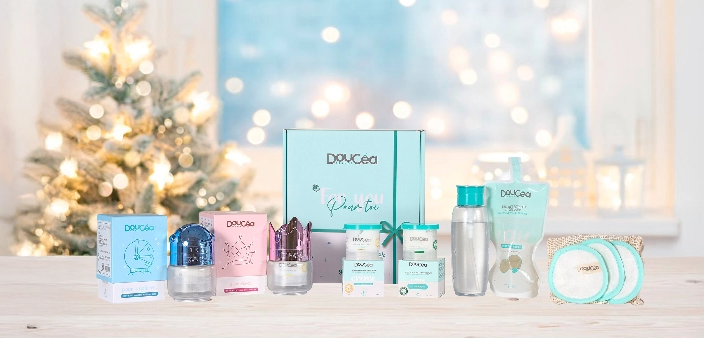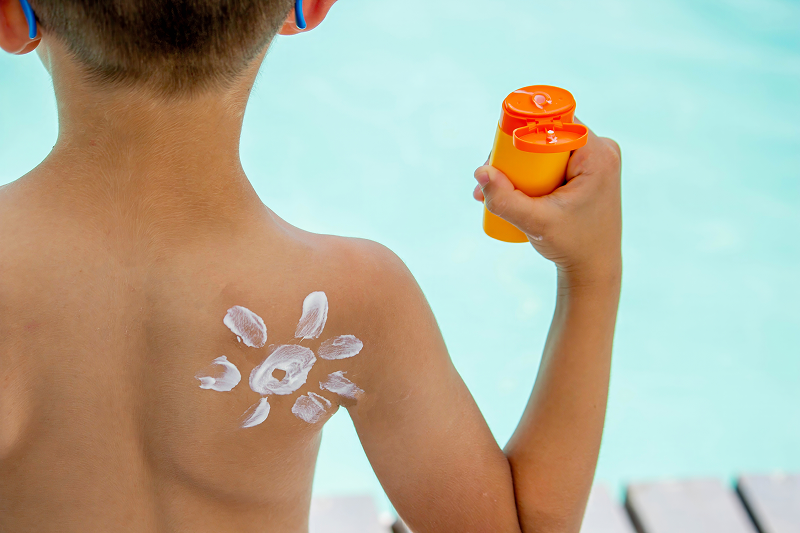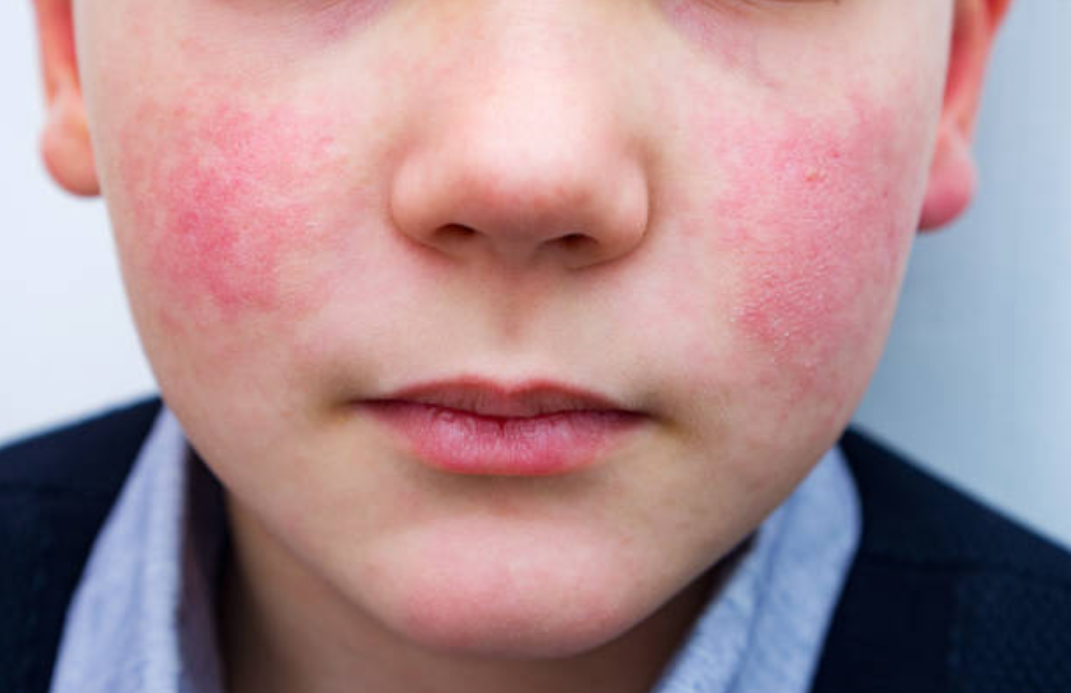Summer means sunshine and outdoor fun, but also brings skin risks. UV rays can cause sunburns, heatstroke, or solar allergies in the short term—and premature aging or even skin cancers in the long run. It’s therefore crucial to adopt healthy habits to protect everyone’s skin during the hot season. Here are 10 essential tips to keep your skin healthy and glowing all summer, including specific advice for children.
1. Use effective sun protection
Sunscreen is your best ally against UV damage. Choose a broad-spectrum sunscreen (UVA and UVB) with SPF 30 at minimum, or SPF 50 for fair skin or intense sun. Apply generously over all exposed areas 15–30 minutes before going outside—don’t forget ears, neck, décolleté, arms, legs, the tops of your feet, and the back of your neck. Use enough product (e.g. one teaspoon for your face, several tablespoons for your body) and reapply at least every two hours, especially after swimming, sweating heavily, or towel drying. Opt for a water-resistant formula if you’ll be swimming. Remember: no sunscreen offers 100% protection—don’t prolong sun exposure. Also, store sunscreen in a cool, shaded place and close the cap tightly after use to maintain its effectiveness.
2. Wear protective clothing and accessories
Don’t rely solely on sunscreen—physical barriers add extra protection. Cover up with lightweight but tightly woven fabrics: long-sleeve shirts, pants, or beach wraps. UV-protective textiles are especially useful for kids and sensitive skin. Darker colors provide better protection than light ones—wet white fabric offers almost no UV defense. Also, wear wide-brimmed hats or caps to protect your face and scalp, and choose sunglasses (CE‑marked with high UV filter) to shield your eyes and delicate skin around them.
3. Avoid sun exposure during peak hours
UV radiation peaks at solar noon, roughly between 11 am and 4 pm in metropolitan France. Try to avoid sun exposure during this time. Plan outdoor activities in the early morning or late afternoon when the sun is lower. If you must go out around midday, stay in the shade (under trees, an umbrella, a gazebo), and use protective clothing and hats as mentioned above. This simple measure reduces the risk of sunburn, heatstroke, and dehydration.
4. Monitor the UV index and adapt protection
Make a habit of checking the daily UV index via weather websites, mobile apps, or dedicated apps like France’s “EcoSun” (formerly “SoleilRisk”). The UV index indicates the risk level of sun exposure. When it’s ≥3, seek shade from noon to 4 pm and apply SPF 30 or higher. High UV levels mean you can get sunburned in as little as 15 minutes without protection. Knowing the UV index helps you adapt your protective measures—wearing hats, clothing, and high-SPF sunscreen—especially in bright locations like mountains or tropical regions. Keep in mind that clouds or cooler temperatures don’t block UV rays. So double-check the UV index each morning and act accordingly.
5. Stay hydrated by drinking regularly
Summer heat and sun increase fluid loss—and when the body is dehydrated, the skin becomes more vulnerable and dull. Drink water regularly throughout the day, even if you don’t feel very thirsty. Adults should aim for at least 1.5–2 liters of water per day, more if active or exposed to heat. Hydration supports skin elasticity and function. Include unsweetened drinks like sparkling water or iced herbal teas, and limit alcohol or caffeine. Eat moisture-rich foods like watermelon, melon, cucumber, and citrus—these hydrate and deliver nutrients. Keep water on hand, and especially encourage kids and seniors to drink frequently.
6. Moisturize and soothe your skin daily
Sun, heat, pool chlorine, and seawater can dry out and irritate skin. Counteract with a daily hydration ritual. Every evening after sun exposure, apply a generous amount of moisturizer or after-sun lotion. Look for soothing formulas—such as those containing floral waters or sweet almond oil—to help restore the skin’s lipid barrier and relieve heat sensations. For minor sunburns, use soothing lotions like calendula or glycerin-based gels, or natural aloe vera gel. Refrigerating after-sun products enhances their calming effect. Also, use a light daytime moisturizer (ideally with SPF) each morning to combat dehydration and environmental aggression. Well-hydrated skin feels comfortable, resists better, and keeps a radiant tan longer without peeling.
7. Adapt your skincare routine to summer
Skin needs change in summer due to heat, humidity, and sweat. Choose lighter textures—gels, fluid emulsions, or hyaluronic acid serums—instead of thick occlusive creams. Opt for non-comedogenic and alcohol-free formulas to keep pores clear—this is especially important when using sunscreen and sweating. If you wear makeup, mineral-based products with SPF are great: they offer protection and allow the skin to breathe. A light day cream with SPF suffices for city wear. Adapting your routine ensures comfort, prevents breakouts, and maintains healthy skin.
8. Beware of reflection and cloudy skies
Don’t let clouds or shade lull you into a false sense of security—UV rays still reach you. A beach umbrella blocks only ~50% of UV rays. Light cloud cover doesn’t reduce UV, so you might burn on a cloudy day. Reflective surfaces intensify exposure: snow (50–80%), sand (5–20%), water (~20%). That means you receive direct and reflected rays while at the beach, pool, at altitude, or even in front of a white wall. Cool breezes can mask the sun’s effect, so continue sun protection—clothing, hats, sunscreen—no matter the conditions.
9. Avoid risky behaviors
Some trends pose real risks to skin health and should be avoided:
-
“Sunburn art”: deliberately burning skin to create patterns is dangerous and irresponsible—every sunburn damages DNA and increases cancer risk.
-
Tanning beds: artificial UV doesn’t protect skin before sun exposure and actually adds to damage. Health authorities advise avoiding them—they deliver intense UV doses equivalent to several hours of tropical sun in minutes.
-
A tan is not a protective barrier—it’s a defense reaction, not immunity. Darker skin can still be harmed without proper protection. Chasing a tan accelerates aging (wrinkles, spots).
Safe alternative: self-tanners provide color without UV damage. Choose skin health over premature aging.
10. Monitor your skin and consult when needed
Part of caring for skin in summer is staying alert to changes. Despite precautions, skin issues may arise—changing moles, suspicious spots, persistent irritation, etc. Perform a head‑to‑toe self‑check monthly in front of a mirror (or with someone’s help for hard-to-see areas). If you notice anything unusual—changes in a mole’s shape, color, size; new wart-like spots; bleeding lesions—consult a dermatologist promptly. Annual dermatological exams are also advisable if you have many moles, a family history of melanoma, or past extensive sun exposure. Early detection of precancerous or cancerous lesions is vital. Listening to your skin and acting quickly keeps it healthy all year long.
Specific tips for children
Kids’ skin is thinner, more delicate, and offers less natural protection—it’s more prone to sunburn. Infants and toddlers are also more vulnerable to dehydration or heatstroke. Sun exposure during early childhood irreversibly affects long-term skin health. Protective measures are therefore even more essential:
-
No direct sun for babies (<12 months): Never expose babies directly to the sun. Their defense mechanisms are minimal and they burn fast. Keep them in the shade at all times—under trees, umbrellas, stroller canopies—and never let them nap in the sun.
-
Avoid peak hours: For older children, adhere to the 12 pm–4 pm blackout. Plan outdoor play or outings in early morning or late afternoon. Indoors or shaded spaces are best midday.
-
Full-body coverage: Use lightweight, long‑sleeved shirts or blouses, long pants or shorts in dark colors. Use wide-brimmed hats or legionnaire caps (with neck flap) to protect head, neck, and face. Use UV-protective children’s sunglasses (category 3 or 4).
-
High‑SPF sunscreen: Apply SPF 50+ sunscreen made for sensitive skin and fragrance-free on all exposed areas—even in the shade. Reapply every two hours and after swimming, as kids move and splash often.
-
Frequent hydration: Children dehydrate faster than adults. Encourage regular water drinking, even if they don’t ask. Offer water or milk often to infants. Proper hydration helps their skin tolerate heat better.
-
Lead by example: Kids imitate what they see. Wear hats, apply sunscreen visibly, and seek shade—you’ll reinforce good habits and show that sun protection is simply part of daily summer life.
By following these 10 essential tips—and being particularly careful with children—you can fully enjoy summer while minimizing skin risks. Simple actions like sunscreen, hydration, sunscreen-safe routines, and sensible timing of outdoor exposure help prevent sunburns, premature aging, and long‑term skin damage. Summer can equal enjoyment and safety: care for your skin now, and your future self will thank you.
















